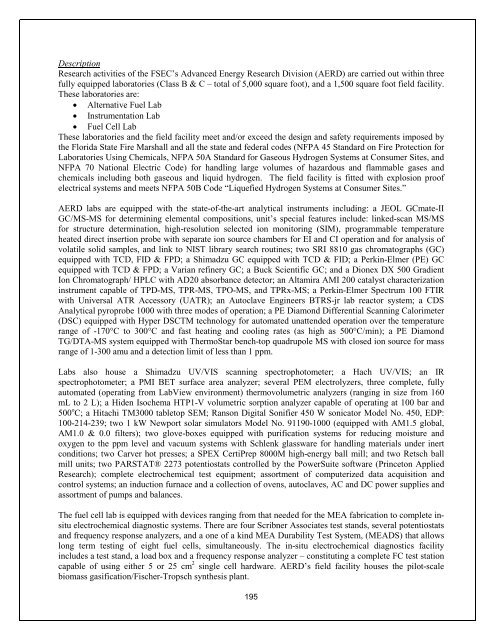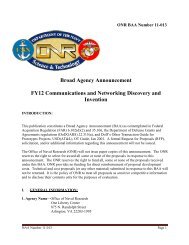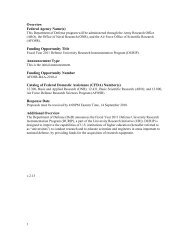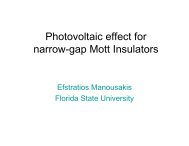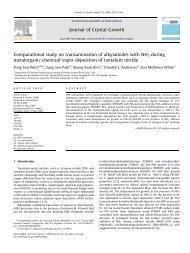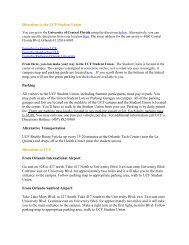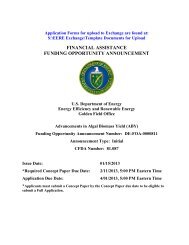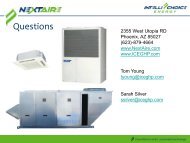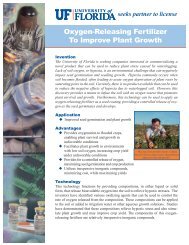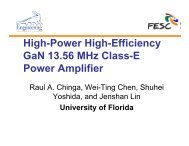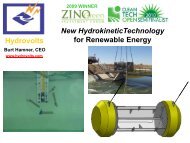Annual Report- Part III - Florida Energy Systems Consortium
Annual Report- Part III - Florida Energy Systems Consortium
Annual Report- Part III - Florida Energy Systems Consortium
Create successful ePaper yourself
Turn your PDF publications into a flip-book with our unique Google optimized e-Paper software.
DescriptionResearch activities of the FSEC’s Advanced <strong>Energy</strong> Research Division (AERD) are carried out within threefully equipped laboratories (Class B & C – total of 5,000 square foot), and a 1,500 square foot field facility.These laboratories are:• Alternative Fuel Lab• Instrumentation Lab• Fuel Cell LabThese laboratories and the field facility meet and/or exceed the design and safety requirements imposed bythe <strong>Florida</strong> State Fire Marshall and all the state and federal codes (NFPA 45 Standard on Fire Protection forLaboratories Using Chemicals, NFPA 50A Standard for Gaseous Hydrogen <strong>Systems</strong> at Consumer Sites, andNFPA 70 National Electric Code) for handling large volumes of hazardous and flammable gases andchemicals including both gaseous and liquid hydrogen. The field facility is fitted with explosion proofelectrical systems and meets NFPA 50B Code “Liquefied Hydrogen <strong>Systems</strong> at Consumer Sites.”AERD labs are equipped with the state-of-the-art analytical instruments including: a JEOL GCmate-IIGC/MS-MS for determining elemental compositions, unit’s special features include: linked-scan MS/MSfor structure determination, high-resolution selected ion monitoring (SIM), programmable temperatureheated direct insertion probe with separate ion source chambers for EI and CI operation and for analysis ofvolatile solid samples, and link to NIST library search routines; two SRI 8810 gas chromatographs (GC)equipped with TCD, FID & FPD; a Shimadzu GC equipped with TCD & FID; a Perkin-Elmer (PE) GCequipped with TCD & FPD; a Varian refinery GC; a Buck Scientific GC; and a Dionex DX 500 GradientIon Chromatograph/ HPLC with AD20 absorbance detector; an Altamira AMI 200 catalyst characterizationinstrument capable of TPD-MS, TPR-MS, TPO-MS, and TPRx-MS; a Perkin-Elmer Spectrum 100 FTIRwith Universal ATR Accessory (UATR); an Autoclave Engineers BTRS-jr lab reactor system; a CDSAnalytical pyroprobe 1000 with three modes of operation; a PE Diamond Differential Scanning Calorimeter(DSC) equipped with Hyper DSCTM technology for automated unattended operation over the temperaturerange of -170°C to 300°C and fast heating and cooling rates (as high as 500°C/min); a PE DiamondTG/DTA-MS system equipped with ThermoStar bench-top quadrupole MS with closed ion source for massrange of 1-300 amu and a detection limit of less than 1 ppm.Labs also house a Shimadzu UV/VIS scanning spectrophotometer; a Hach UV/VIS; an IRspectrophotometer; a PMI BET surface area analyzer; several PEM electrolyzers, three complete, fullyautomated (operating from LabView environment) thermovolumetric analyzers (ranging in size from 160mL to 2 L); a Hiden Isochema HTP1-V volumetric sorption analyzer capable of operating at 100 bar and500 o C; a Hitachi TM3000 tabletop SEM; Ranson Digital Sonifier 450 W sonicator Model No. 450, EDP:100-214-239; two 1 kW Newport solar simulators Model No. 91190-1000 (equipped with AM1.5 global,AM1.0 & 0.0 filters); two glove-boxes equipped with purification systems for reducing moisture andoxygen to the ppm level and vacuum systems with Schlenk glassware for handling materials under inertconditions; two Carver hot presses; a SPEX CertiPrep 8000M high-energy ball mill; and two Retsch ballmill units; two PARSTAT® 2273 potentiostats controlled by the PowerSuite software (Princeton AppliedResearch); complete electrochemical test equipment; assortment of computerized data acquisition andcontrol systems; an induction furnace and a collection of ovens, autoclaves, AC and DC power supplies andassortment of pumps and balances.The fuel cell lab is equipped with devices ranging from that needed for the MEA fabrication to complete insituelectrochemical diagnostic systems. There are four Scribner Associates test stands, several potentiostatsand frequency response analyzers, and a one of a kind MEA Durability Test System, (MEADS) that allowslong term testing of eight fuel cells, simultaneously. The in-situ electrochemical diagnostics facilityincludes a test stand, a load box and a frequency response analyzer – constituting a complete FC test stationcapable of using either 5 or 25 cm 2 single cell hardware. AERD’s field facility houses the pilot-scalebiomass gasification/Fischer-Tropsch synthesis plant.195


